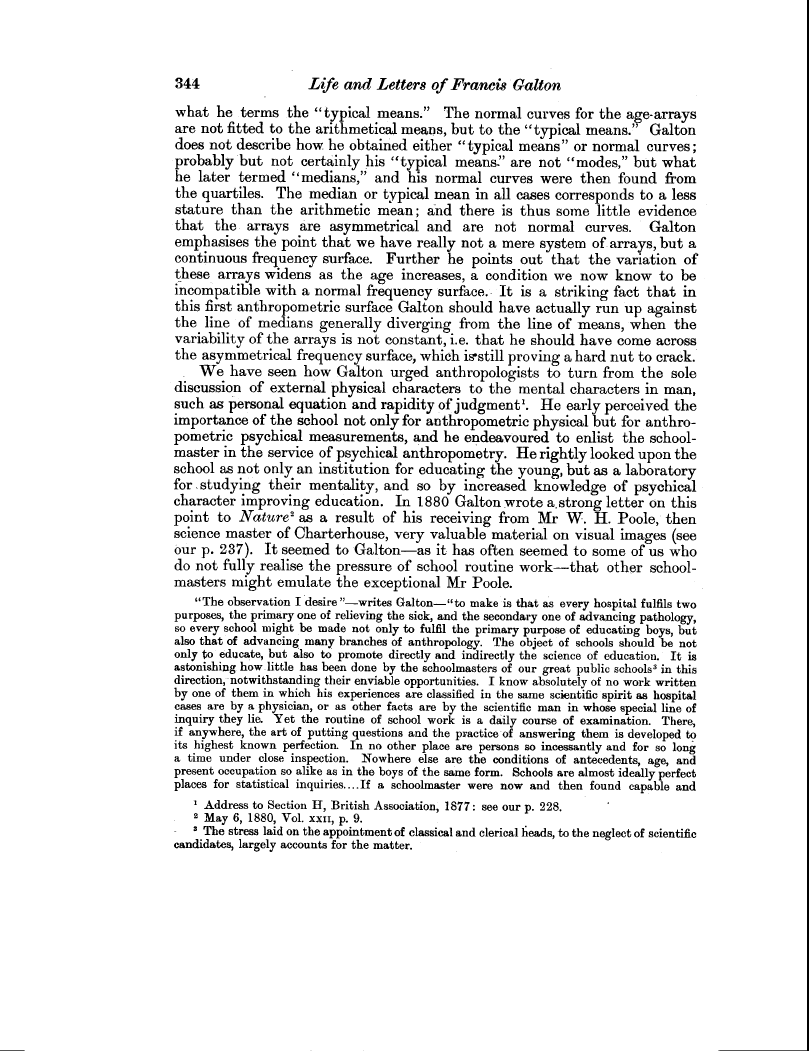344 Life and Letters of Francis Galton
what he terms the "typical means." The normal curves for the age-arrays are not fitted to the arithmetical means, but to the "typical means." Galton does not describe how he obtained either "typical means" or normal curves; probably but not certainly his "typical means:" are not "modes," but what he later termed "medians," and his normal curves were then found from the quartiles. The median or typical mean in all cases corresponds to a less stature than the arithmetic mean; and there is thus some little evidence that the arrays are asymmetrical and are not normal curves. Galton emphasises the point that we have really not a mere system of arrays, but a continuous frequency surface. Further he points out that the variation of these arrays widens as the age increases, a condition we now know to be incompatible with a normal frequency surface., It is a striking fact that in this first anthropometric surface Galton should have actually run up against the line of medians generally diverging from the line of means, when the variability of the arrays is not constant, i.e. that he should have come across the asymmetrical frequency surface, which instill proving a hard nut to crack.
. We have seen how Galton urged anthropologists to turn from the sole discussion of external physical characters to the mental characters in man, such as personal equation and rapidity of judgment'. He early perceived the importance of the school not only for anthropometric physical but for anthropometric psychical measurements, and he endeavoured to enlist the schoolmaster in the service of psychical anthropometry. He rightly looked upon the school as not only an institution for educating the young, but as a laboratory for, studying their mentality, and so by increased knowledge of psychical character improving education. In 1880 Galton wrote a. strong letter on this point to Nature' as a result of his receiving from Mr W. H. Poole, then science master of Charterhouse, very valuable material on visual images (see our p. 237). It seemed to Galton-as it has often seemed to some of us who do not fully realise the pressure of school routine work-that other schoolmasters might emulate the exceptional Mr Poole.
"The observation I desire "-writes Galton-"to make is that as every hospital fulfils two purposes, the primary one of relieving the sick, and the secondary one of advancing pathology, so every school might be made not only to fulfil the primary purpose of educating boys, but also that of advancing many branches of anthropology. The object of schools should be not only to educate, but also to promote directly and indirectly the science of education. It is astonishing how-little has been done by the schoolmasters of our great public schools' in this direction, notwithstanding their enviable opportunities. I know absolutely of no work written by one of them in which his experiences are classified in the same scientific spirit as hospital cases are by a physician, or as other facts are by the scientific man in whose special line of inquiry they lie. Yet the routine of school work is a daily course of examination. There, if anywhere, the art of putting questions and the practice of answering them is developed to its highest known perfection. In no other place are persons so incessantly and for so long a time under close inspection. Nowhere else are the conditions of antecedents, age, and present occupation so alike as in the boys of the same form. Schools are almost ideally perfect
places for statistical inquiries .... If a schoolmaster were now and then found capable and
1 Address to Section II, British Association, 1877: see our p. 228. 2 May 6, 1880, Vol. xxii, p. 9.
' The stress laid on the appointment of classical and clerical heads, to the neglect of scientific candidates, largely accounts for the matter.

